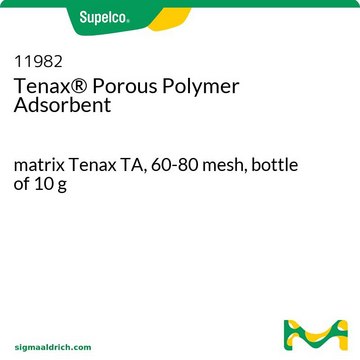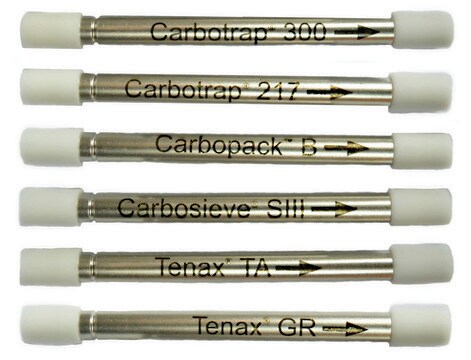28718-U
Tenax® TA / Carboxen® 1018 Thermal Desorption Tube
glass, O.D. x I.D. x L 1/4 in. × 3 1/2 in., preconditioned, pkg of 10 ea
Synonym(s):
Tenax TA/Carbon Thermal Desorption Tube (stainless)
About This Item
Recommended Products
product name
Tenax® TA / Carboxen® 1018, glass TD tube, preconditioned, O.D. × L 1/4 in. × 3 1/2 in., Sealed with (Swagelok® End-Fittings), pkg of 10 ea
material
glass TD tube
Quality Level
Agency
EPA TO-1,IP-1B
feature
preconditioned
packaging
pkg of 10 ea
greener alternative product characteristics
Waste Prevention
Safer Solvents and Auxiliaries
Learn more about the Principles of Green Chemistry.
sustainability
Greener Alternative Product
technique(s)
active air sampling: suitable
O.D. × L
1/4 in. × 3 1/2 in.
matrix
Carboxen® 1018 carbon molecular sieve (CMS)
Tenax TA porous polymer
application(s)
air monitoring
environmental
industrial hygiene
compatibility
for use with PerkinElmer, Markes, DANI, OI Analytical, and Shimadzu Instruments
greener alternative category
General description
Application
Legal Information
Signal Word
Warning
Hazard Statements
Precautionary Statements
Hazard Classifications
Eye Irrit. 2 - Skin Irrit. 2 - STOT SE 3
Target Organs
Respiratory system
Storage Class Code
11 - Combustible Solids
WGK
WGK 3
Flash Point(F)
Not applicable
Flash Point(C)
Not applicable
Choose from one of the most recent versions:
Certificates of Analysis (COA)
Sorry, we don't have COAs for this product available online at this time.
If you need assistance, please contact Customer Support.
Already Own This Product?
Find documentation for the products that you have recently purchased in the Document Library.
Customers Also Viewed
Our team of scientists has experience in all areas of research including Life Science, Material Science, Chemical Synthesis, Chromatography, Analytical and many others.
Contact Technical Service












